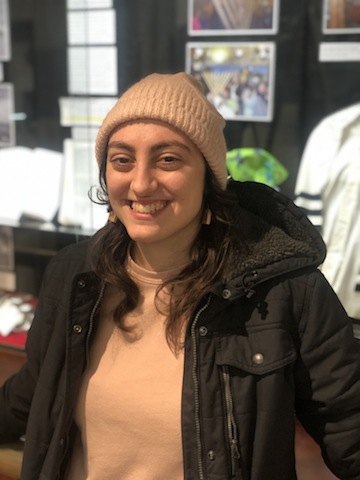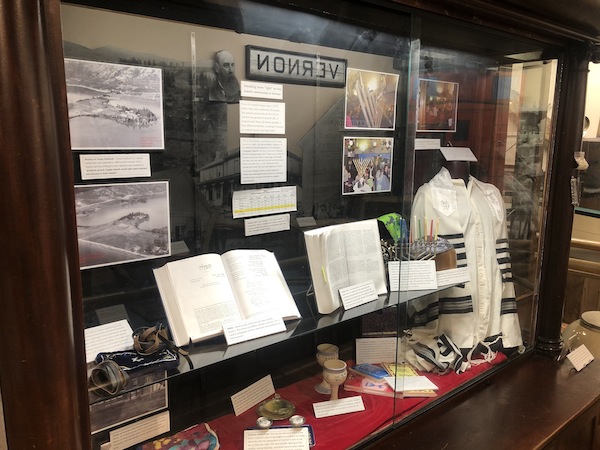The exhibit Shedding Some Light on the Jewish Community in Vernon is at the Museum and Archives of Vernon until the beginning of April. (photo from Alexandra Fox)
If you are passing through the Okanagan between now and the beginning of April, check out the exhibit on Vernon’s Jewish community, which recently went up at the Museum and Archives of Vernon. Last month, I sat down with collections and exhibits intern Alexandra Fox to chat about it.
Between sips of hot chocolate at a local café, we bonded over the fact that we are two queer Jews from the Lower Mainland, who grew up spending winters up on SilverStar Mountain Resort with family, and both find ourselves currently in Vernon. We also share a love of local Jewish community history.
Carmel Tanaka: What inspired you to curate an exhibit about Vernon’s Jewish community?
Alexandra Fox: When I came here, I found that there weren’t a lot of openly Jewish people and most of the non-Jewish community was not aware of the Jewish community. I wanted to shed some light on a community that has often gone under the radar and that’s why I titled the exhibit Shedding Some Light on the Jewish Community in Vernon. It was partly a pun on certain traditions of lighting candles, too.
Basically, I wanted the exhibit topic to be something that meant a lot to me. I come from a multifaith family, with my dad being Jewish and my mom being Protestant. Growing up, Jewish identity had been a confusing thing for me as, technically, I am not Jewish, due to it being matrilineal but it was always the religion I connected with the most. Maybe this is in part due to always being told that I look Jewish. However, you cannot always tell if someone is Jewish, as there is so much diversity in the community. I wanted to curate this exhibit so that I could honour my identity a bit more.
CT: What have been some of the reactions to the exhibit?
AF: The reactions to the exhibit have all been positive so far and I believe it will stay that way. I’ve had a few questions about certain Jewish traditions that are represented by the items in the exhibit but they have all been very respectful. Some of my co-workers have also congratulated me on making an excellent exhibit.
CT: During the research and curation of the exhibit, did anything surprise you? Did you face any challenges?
AF: I was surprised by how small the Jewish community was when it started in the 1970s – it numbered only 20 people – and how small it really still is. The 2021 Census … in the case of Vernon, it shows that most Jewish people identify as Jewish but are not practising. This trend doesn’t surprise me because I think a lot of Jewish people in other communities are the same, but the numbers of Jews (both ethnically and religiously) are so small.
Some of the challenges that I faced while creating the exhibit were during the call-out phase and during the editing phase. Since our museum didn’t have any Jewish objects in the collection, I had to do a call-out to the community…. I felt limited to reaching out to practising Jews rather than those who identify as ethnically Jewish because I didn’t have a lens into the community and was only able to reach out to the Okanagan Jewish Community Centre and Chabad House. Only the Okanagan Jewish Community Centre agreed to loan some objects to the museum for the exhibit.
CT: What resources did you use in compiling the exhibit?

AF: The resources I used to compile the exhibit were from Census data analyses, the Okanagan Jewish Community Centre website, the Chabad website, some existing pictures in Vernon’s museum archives, as well as Ronnie Tessler’s research from the Jewish Museum and Archives of B.C., which focused more on Kelowna than on Vernon.
CT: Community archival projects are limited to the availability of resources. If you were able to continue researching Vernon’s Jewish community, what stories would you like to dive further into?
AF: Only after finishing the exhibit did I find out that one of the people who developed SilverStar was Jewish, so if I were to continue researching Vernon’s Jewish community, I would totally dive further into finding out about that family. I would like to know if the SilverStar community even knew about Dr. [Michael] Lattey being Jewish.
Also, if I were able to continue researching Vernon’s Jewish community and developing the exhibit, I would extend the call-out to more community members so that I could expand the range of people represented by the exhibit, such as Vernon’s very own, the Saucy Soprano Melina Schein, who won Food Network’s Wall of Bakers and who I only found out about after the exhibit.
As an intern at the museum, I seemed to be quite limited in who I could extend the call-out to and I wish I had met with you, Carmel, before the coffee meetup because then I could reach more community members, especially those not affiliated with community organizations or synagogues.
I would also like to dive deeper into the 2021 potential sale of Nazi memorabilia by Dodd’s Auction, a local and much beloved auction house. The memory of the Holocaust is very present in Vernon’s Jewish community so when these items were included in the auction, the community – Jewish and non-Jewish – successfully demanded that it be halted, and the items were returned to the consigner. It’s important to me to ensure that these stories and this part of local history are heard.
CT: Your exhibit, the first of its kind in Vernon to my knowledge, is a wonderful “Jewifying” of museum space. Why is it important for the Jewish community to share our stories in rural towns like Vernon?
AF: “Jewifying” the museum space, as with creating space for any other groups that have been historically left out of museum space, is a very important thing. I think it is especially important in museums located in rural towns because these are the places that are most likely to have fewer interactions with any minority groups…. In many rural towns, the Jewish people (or any other minority group) feel like they have to hide that part of themselves and I think it is very important to show them, and the rest of the community, that you don’t have to hide your identity.
CT: Is there anything else that you’d like to add?
AF: I’d like to add that this is the first exhibit I have curated and, although limited by time and other factors, I poured my heart into this exhibit, which had a personal connection to me. When embarking on this exhibit, as mentioned earlier, I wanted to do something that was personal to me. It was either something about Jewishness or queerness and I decided to choose the former. My sister is in Israel right now, volunteering on a kibbutz, and I felt that curating this exhibit would be my way of honouring my identity.
***
For more information on the exhibit, visit vernonmuseum.ca/vernon-museum/vernons-jewish-community.
Carmel Tanaka is the founder and executive director of JQT Vancouver, and curator of the B.C. Jewish Queer and Trans Oral History Project (jqtvancouver.ca/jqt-oral-history-bc) and the Jewpanese Oral History Project (@JewpaneseProject on Instagram). She has family ties to Vernon, and it was a Japanese-Canadian friend who tipped her about Fox’s exhibit.

